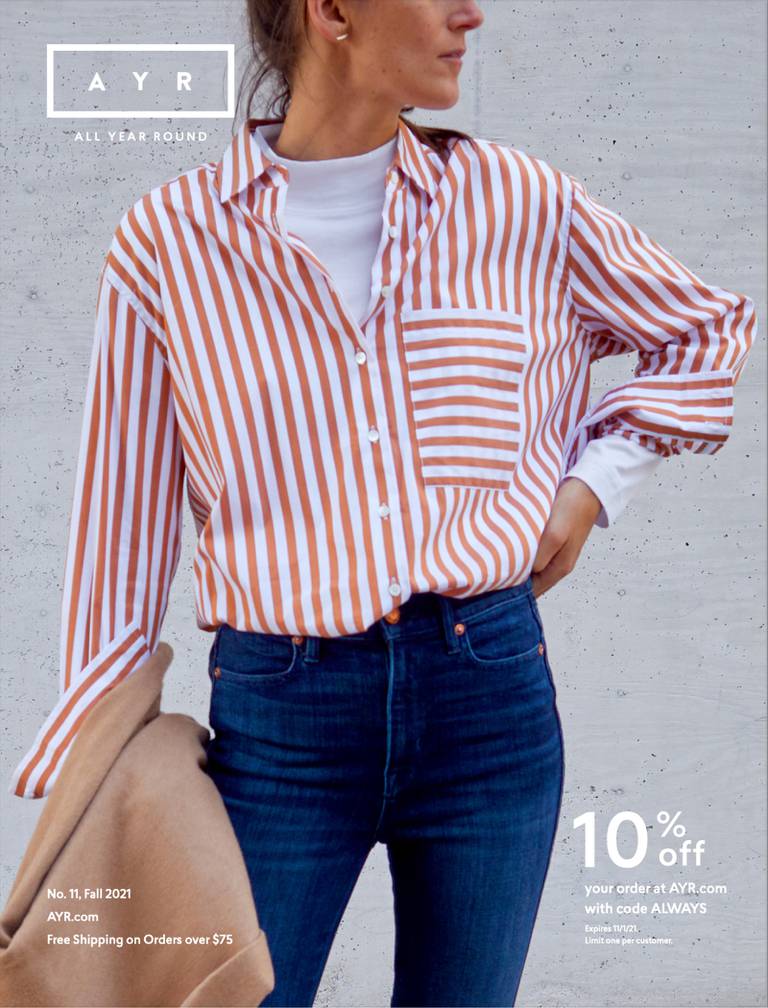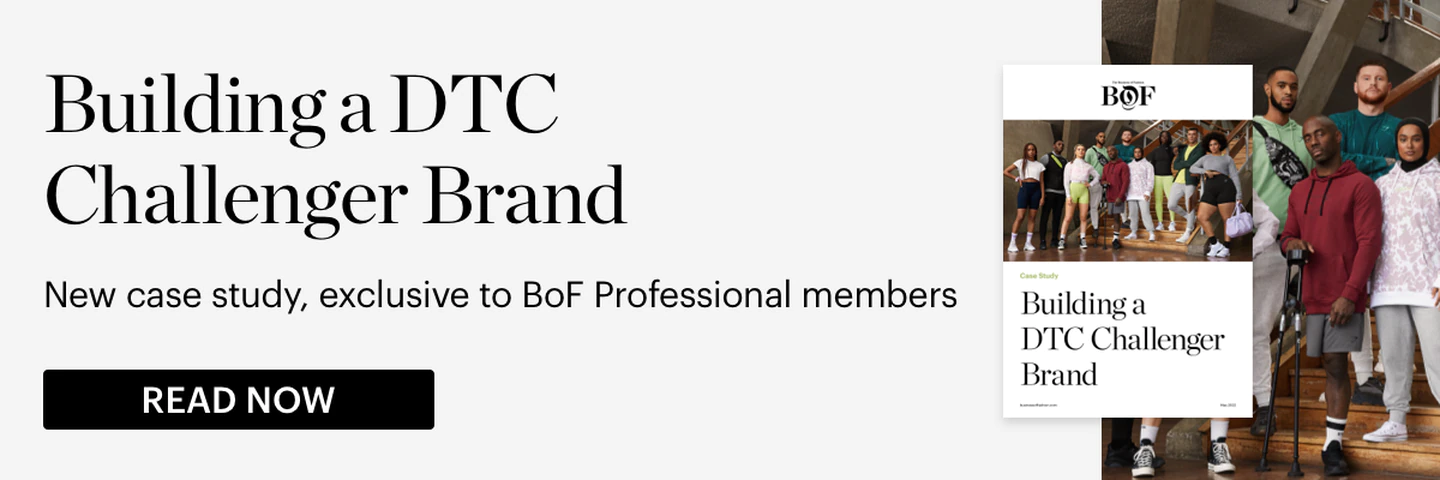
AYR is a direct-to-consumer survivor.
The brand started in 2014 as an attempt by Bonobos to see whether the e-commerce pioneer’s “perfect pair of pants” approach to wardrobe staples could prove as big a hit with women as it had with men. The experiment failed — needing to stem losses while it looked for a buyer, Bonobos decided to shut down AYR within two years.
Rather than halt operations, co-founders Maggie Winter and Max Bonbrest struck out on their own. With about $2 million in friends and family funding — including from Bonobos founder Andy Dunn — AYR relaunched as an independent brand selling jeans and button-up shirts in 2016.
From the beginning, AYR operated much like any other DTC brand: advertising on Instagram to find customers, and making the vast majority of sales through its own website.
But the startup did it on a shoestring budget. To date, AYR has raised a total of $6 million. That’s in contrast to Bonobos, which had raised $128 million by the time Walmart bought it in 2017. AYR just hired its first full-time marketing employee, and Winter still shoots and edits AYR’s catalogue spreads, where Bonbrest often models.
Lately though, not having access to a bottomless well of venture capital funding has looked like a blessing in disguise. AYR, which is on track to reach $60 million in sales this year, has grown slower and attracted a fraction of the media attention of DTC brands like Everlane and Outdoor Voices. But it’s also avoided the turmoil that’s recently gripped many fashion start-ups. As e-commerce growth has slowed, some of the last decade’s biggest digital stars, including Warby Parker, Allbirds and Glossier, have pivoted to opening hundreds of stores or signing wholesale retail deals.
AYR has no plans to change course, Winter told BoF. It still generates 97 percent of sales from its own website. Next month, it will launch a menswear collection, the first major category expansion by the brand.
“Our company’s mantra is healthy growth,” said Winter. “It’s not about the size or the speed of the business … There’s a real beauty to staying small.”
AYR is a prime example of how start-ups can build their businesses in a difficult fundraising environment, according to Andrea Wasserman, a retail veteran who worked at Nordstrom when it invested in Bonobos in 2012.
“Here’s a company that’s quiet and humble and focussed on quality,” Wasserman said. “It’s a great example for future founders on how to build a company in a sustainable way.”
There’s a real beauty to staying small.
A Merchandiser’s Vision
AYR was born out of a meeting a decade ago between Winter and Dunn, the founder of Bonobos, whose ideas about digitally native vertical brands, or DNVBs, shaped the whole category.
Winter had been a merchandiser at J.Crew, working under Mickey Drexler, who with creative director Jenna Lyons built J.Crew into a bona fide fashion destination, one that offered shoppers an updated point-of-view on preppy staples.
Winter’s vision for her brand wasn’t far off: her initial lookbook included vintage photos of models donning chambray shirts and French New Wave ingénues in breton tops. Rather than introducing trendy pieces every season, AYR, which stands for all year round, would focus on the basics, starting with jeans and oxford shirts.

At the time, hero products were all the rage in the burgeoning DTC space. But Winter, who was 29 when she created the brand, never saw AYR as a so-called disruptor. And rather than pinning her hopes on becoming a unicorn, she was more inspired by fashion labels like A.P.C. and Ralph Lauren that gradually built their reputations for selling pieces that could be worn year in and year out.
“We were always more traditional than normal DTC brands,” Winter said.
Dunn was immediately sold. Winter recruited her college best friend Bonbrest, who had been working in PR at the time, and AYR launched in 2014 as a subsidiary under Bonobos.
Within two years, Bonobos made the decision to shut down AYR. But it gave Winter the opportunity to take the intellectual property and run it herself. She reached out to 75 investors, and a dozen wrote her checks, including Dunn.
By 2016, the now-independent AYR was up and running, without missing a day of sales. Rather than looking to her DTC predecessors, Winter built her strategy as a CEO from the lessons she learned from Drexler.
“Having grown up learning from a leader like Mickey, the fundamentals are so ingrained — great product, champion your customer, great service, fair prices,” Winter said. “Those lessons, I can’t imagine unlearning. I’m not interested in working in this industry if those values don’t exist.”
DTC With Caution
As a small company, AYR was able to pivot quickly when the pandemic hit. It reduced its headcount to five, and began using catalogues to supplement its digital marketing efforts. Scrappiness was key. Bonbrest would tap her family members to model for the shoots alongside herself. To save money on hair and makeup, some photos were cropped from the neck up.
Catalogues now account for 50 percent of marketing spend, according to CFO Meg Covington, with digital ads making up the rest. The two tactics work in tandem to convert shoppers, most of whom need to see multiple ads before they make a purchase.

“We’re conservative in how we spend, and we don’t push into [spending] to try to hit a sales plan,” Covington said.
After posting an Ebitda margin — a measure of profitability — in the mid-teens last year, the company decided it was the right time to venture into men’s.
“We wanted to be profitable before we invest some of that profit into expanding our brand,” said Winter. The debut assortment includes similar wardrobe staples, including sweaters and trousers, designed by Brice Pattison, Winter’s husband and former designer director at Todd Snyder.
AYR approaches manufacturing with a general cautious attitude, producing in small batches and testing out products first to avoid excess inventory. It hasn’t always gotten everything right.
“In the beginning I didn’t love their jeans but I’ve since bought a number of items,” said Wasserman.
The bulk of its growth today comes from repeat customers, Covington said. Among them is retail consultant Gabriella Santaniello, who found the brand on Instagram years ago and has continued to shop from its e-commerce site.
“I don’t know what it is but it’s like they’ve got this secret formula,” Santaniello said, also noting AYR’s effective customer service. “Through Instagram ads and their transparency, they just hook the customer.” She owns four pairs of jeans and five tops from the brand.
With a reliable customer base and a tempered approach to expansion, AYR sees the $100 million benchmark in sales on its horizon, Winter said. But the goal is longevity, not volume.
“It’s not our goal to be a billion-dollar brand,” she said. “Really what we’re looking to do is build something that will last for a long time.”




